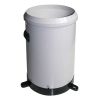KISTERS TB3 Tipping Bucket Rain Gauge
Features
- Long-term stable calibration
- Accuracy not affected by rainfall intensity
- Minimal maintenance required
- Free ground shipping
- Expedited repair and warranty service
- Lifetime technical support
- More
Overview
The KISTERS TB3 is a high-quality tipping bucket rain gauge for measuring rainfall and precipitation in urban and rural locations. Due to the integrated siphon, the gauge delivers high levels of accuracy across a broad range of rainfall intensities.
Reliable Results
The TB3’s tried and proven design ensures long-term, accurate, and repeatable results. It is manufactured from high-quality, durable materials that provide long-term stability in the harshest environments. It consists of a robust powder-coated aluminum enclosure, an aluminum base and stainless steel finger filter and fasteners.
Easy Maintenance
TB3 provides a finger filter that ensures the collector catch area remains unblocked when leaves, bird droppings and other debris find their way into the catch. The TB3’s base incorporates two water outlets at the bottom, allowing water collection and data verification. Maintenance of the TB3 is easy because removal of the outer enclosure and access to the tipping bucket mechanism and finger filter can be done by using the quick-release fasteners.
Dual Output
TB3 includes a dual output 24 VDC reed switch allowing for output redundancy or the addition of a second data logger. The reed switch incorporates varistor protection against surges that may be induced on long, inappropriately shielded signal cables.
| Resolution | 0.1 mm, 0.2 mm, 0.5 mm, 1.0 mm, 0.01 inch |
| Accuracy |
|
| Range | 700 mm per hour |
| Material |
|
| Pivots | Round sapphire pivots with hard stainless steel shaft |
|
Dimensions & Mass |
|
| Environmental Conditions |
|
In The News
Spring 2025 Environmental Monitor Available Now
In the Spring 2025 edition of the Environmental Monitor, we highlight partnerships across the world and the importance of collaboration between government agencies, universities, environmental groups, local communities, and other stakeholders. From great white shark research in Cape Cod to monitoring fisheries in Lake Erie, this latest edition underscores partnerships that connect stakeholders in a watershed through environmental data. With an emphasis on data sharing, a combination of real-time and discrete sampling keeps the public and partners informed of environmental conditions. Our writers also sought out science professionals dedicated to working with peers within and outside of the environmental sector.
Read MoreMonitoring Mariculture in the Gulf of Alaska
The mariculture industry in the Gulf of Alaska has been steadily growing in recent years, guided by ongoing research to help refine farm location and cultivation practices. A subset of aquaculture, mariculture focuses on rearing organisms in the open ocean. In Alaska, finfish farming is illegal, so most farms cultivate kelp, oysters, or a combination of the two. These small, locally operated farms started popping up in the Gulf of Alaska in the early 1990s, when shellfish farming first became legal. Kelp farming did not begin to catch on in the state until 2016. Many of the coastal areas that have grown interested in mariculture are historically commercial fishing communities.
Read MoreSupplying Seattle’s Drinking Water: Using Data Buoys to Monitor the Cedar River Municipal Watershed
Providing clean, safe, and reliable drinking water for the 1.6 million people in the greater Seattle area is a top priority for Seattle Public Utilities (SPU). With limited water supplies, SPU dedicates considerable resources to maintain its watersheds and mountain reservoirs. About 70 percent of Seattle Water comes from the Cedar River Municipal Watershed , and the other 30 percent comes from the South Fork Tolt River Watershed . [caption id="attachment_39574" align="alignnone" width="940"] Data buoy in Chester Morse Lake . (Credit: Kevin Johnson / Seattle Public Utilities) [/caption] Jamie Thompson, a fisheries biologist at SPU, monitors aquatic ecosystems centered on fish listed under the U.S. Endangered Species Act (ESA).
Read More
















